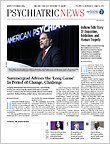During APA’s 2015 annual meeting last month, several of the world’s leading electroconvulsive therapy (ECT) practitioners led a session in which they described the effectiveness of ECT and the patients most likely to benefit from the therapy.
“The biggest problem with ECT is the stigma associated with its use,” said Mount Sinai School of Medicine ECT Services Director Charles Kellner, M.D.
ECT was first introduced as a psychiatric treatment in 1938 for depression. But, by the 1960s, with the rise in available pharmacotherapies and the media’s and film industry’s portrayal of ECT as inhumane, the use of the therapy declined, Kellner said. According to Kellner, today an estimated 1,000,000 people worldwide are treated with ECT, with 100,000 people being treated in the United States.
“People with the most severe form of major depressive disorder do better with ECT than any other treatment,” Kellner explained. Previous studies found ECT to be twice as effective as pharmacotherapies and two to three times more effective than transcranial magnetic stimulation at reducing symptoms of depression in patients with major depressive disorder. Kellner also presented data from a study he published in the American Journal of Psychiatry in 2005 showing that when ECT was administered over the course of six months to patients who were severely depressed, they had fewer suicidal thoughts compared with those who did not receive ECT.
Kellner told the audience that ECT should not be recommended only as a last resort for patients who have failed other forms of therapy. He explained that ECT can be recommended in the most severe cases of major depressive disorder, even before pharmacotherapy.
According to Peter Rosenquist, M.D., vice chair of psychiatry at Georgia Regents University, research has shown that 50 to 60 percent of people with treatment-resistant depression respond to ECT. “People with psychotic depression are the highest responders, with a response rate of 95 percent,” Rosenquist told Psychiatric News, “followed by people with geriatric depression, at 90 percent.”
Both Kellner and Rosenquist emphasized that when determining whether someone is an ideal candidate for ECT, it is important to assess the severity and episodicity of their symptoms as well as family history of mental illness.
Patients with bipolar disorder and schizophrenia may also benefit from using ECT. Previous studies have shown that combined use of ECT and the antipsychotics clozapine or flupenthixol prevents relapse of schizophrenia symptoms by an average of 60 percent. Rosenquist said that though usage rates for ECT are low in the United States for this diagnosis, schizophrenia is the primary indication for ECT in other countries.
One of the main risks associated with ECT is cognitive impairment, which symptoms tend to fall within three main categories:
•
Acute confusional state: No awareness of location and time. Symptoms may last up to three hours following ECT procedure.
•
Antrograde amnesia: Impaired ability to retain new information.
•
Retrograde amnesia: Impaired memory for events that occurred one to three months prior to ECT.
All cognitive ability is restored after 15 days, according to Rosenquist.
“ECT is just like any other therapy—there are risk and benefits,” Rosenquist told Psychiatric News. “Despite the controversy that surrounds ECT, it is a very effective treatment and one of the safest treatments for treating populations with severe mental disorders. It is important for ECT practitioners—and those who refer patients for ECT—to really understand the nature of their patients’ illness to determine whether they are good candidates and healthy enough for ECT.” ■
A video interview of Rosenquist discussing ECT can be viewed
here.


